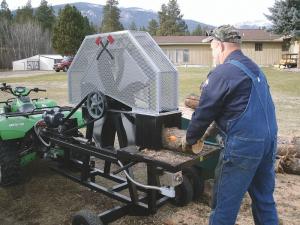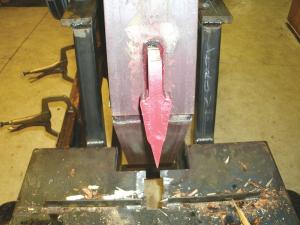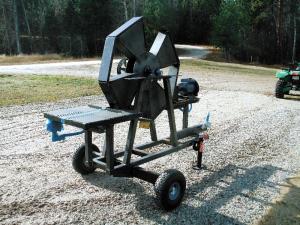“Big Wheel” Log Splitter
A Montana man with a lot of logs to split has designed and built a flywheel log splitter that consists of a heavy spinning steel wheel fitted with an axe head that revolves continuously and splits fast. It mounts on a 2-wheel trailer that has a jack stand on front to provide solid footing.
“We had several forest fires in the area in 2016 and 2017, and local companies were selling semi loads of logs cheap,” says Pat Burrington, Stevensville, Mont. “I found some flywheel splitters from the 1920’s on the internet and thought it was a neat idea. I can split 6 to 8 pieces of wood in just over a minute. My total cost was about $675.
“Because the splitter uses a 3/4-hp. electric motor instead of a gas engine, I can actually use the splitter inside my shop. When it’s snowing and really cold outside, I can be splitting wood inside, next to my wood stove, while wearing a short sleeve shirt.”
The key component of the splitter is the 300-lb., 42-in. dia. steel wheel. Burrington built it by welding together 8 sections of 5-in. by 1-in. thick steel flat bar and adding spokes. He welded a 6-in. long splitting wedge onto one of the sections. The wedge is made from hardened AR400 steel and is pointed at one end. “It works just like an axe head,” says Burrington.
The flywheel rotates at 60 rpm’s, or about once every second. It’s painted bright yellow so it can be easily seen.
“I watch the wheel and when I see the wedge go by, I slip in a piece of wood,” explains Burrington. “As the wheel rotates, the wedge comes down on top of the log, catching about 1/4 of it which is enough to split it in half. I can split wood on its side as easy as standing it up, and by doing it this way my hands aren’t close to the wedge. The splitter can handle up to a 14-in. round log and can even split bigger wood, but that’s where my safety guard is currently set at.”
Burrington admits that the flywheel looks kind of dangerous at first, “but I’ve never had a close call. My wife uses the splitter as much as I do, and she thinks it’s pretty neat.
“The 10:1 right angle gearbox slows the flywheel down a lot, and if a piece of wood gets in crosswise, that’s enough to stop the wheel by slipping the belt. But stopping it won’t cause any damage. Also, plastic brush guards surround the wedge on 3 sides, and an expanded metal screen provides a safety guard around the flywheel.”
The 3/4-hp. electric motor runs at 1,725 rpm’s and goes into a 10:1 right angle gearbox. The motor and gearbox set on a slide, and a heavy-duty spring pulls them forward to tighten the belt. “Whenever I don’t need the splitter I loosen it to keep tension off the belt,” says Burrington.
He bought the jack, hitch, tires and wheels from Tractor Supply Company and got the motor, gearbox and bearings from Surplus Center in Lincoln, Neb. (www.surpluscenter.com). He got the steel he used for the flywheel from CDA Metals in Missoula, Mont.
To build the flywheel, he cut all 8 pieces the exact same length, and set them up in an octagon shape. He then installed a center hub and 4 spokes made from 1/4-in. thick steel plate, and welded everything together. “The flywheel is surprisingly well-balanced,” notes Burrington.
Check out a video of the splitter at FARMSHOW.com.
Contact: FARM SHOW Followup, Pat Burrington, 130 Garnet Drive, Stevensville, Mont. 59870 (ph 406 642-3155; patatrcc@aol.com).

Click here to download page story appeared in.
Click here to read entire issue
“Big Wheel” Log Splitter WOODLOT EQUIPMENT Miscellaneous A Montana man with a lot of logs to split has designed and built a flywheel log splitter that consists of a heavy spinning steel wheel fitted with an axe head that revolves continuously and splits fast It mounts on a 2-wheel trailer that has a jack stand on front to provide solid footing “We had several forest fires in the area in 2016 and 2017 and local companies were selling semi loads of logs cheap ” says Pat Burrington Stevensville Mont “I found some flywheel splitters from the 1920’s on the internet and thought it was a neat idea I can split 6 to 8 pieces of wood in just over a minute My total cost was about $675 “Because the splitter uses a 3/4-hp electric motor instead of a gas engine I can actually use the splitter inside my shop When it’s snowing and really cold outside I can be splitting wood inside next to my wood stove while wearing a short sleeve shirt ” The key component of the splitter is the 300-lb 42-in dia steel wheel Burrington built it by welding together 8 sections of 5-in by 1-in thick steel flat bar and adding spokes He welded a 6-in long splitting wedge onto one of the sections The wedge is made from hardened AR400 steel and is pointed at one end “It works just like an axe head ” says Burrington The flywheel rotates at 60 rpm’s or about once every second It’s painted bright yellow so it can be easily seen “I watch the wheel and when I see the wedge go by I slip in a piece of wood ” explains Burrington “As the wheel rotates the wedge comes down on top of the log catching about 1/4 of it which is enough to split it in half I can split wood on its side as easy as standing it up and by doing it this way my hands aren’t close to the wedge The splitter can handle up to a 14-in round log and can even split bigger wood but that’s where my safety guard is currently set at ” Burrington admits that the flywheel looks kind of dangerous at first “but I’ve never had a close call My wife uses the splitter as much as I do and she thinks it’s pretty neat “The 10:1 right angle gearbox slows the flywheel down a lot and if a piece of wood gets in crosswise that’s enough to stop the wheel by slipping the belt But stopping it won’t cause any damage Also plastic brush guards surround the wedge on 3 sides and an expanded metal screen provides a safety guard around the flywheel ” The 3/4-hp electric motor runs at 1 725 rpm’s and goes into a 10:1 right angle gearbox The motor and gearbox set on a slide and a heavy-duty spring pulls them forward to tighten the belt “Whenever I don’t need the splitter I loosen it to keep tension off the belt ” says Burrington He bought the jack hitch tires and wheels from Tractor Supply Company and got the motor gearbox and bearings from Surplus Center in Lincoln Neb www surpluscenter com He got the steel he used for the flywheel from CDA Metals in Missoula Mont To build the flywheel he cut all 8 pieces the exact same length and set them up in an octagon shape He then installed a center hub and 4 spokes made from 1/4-in thick steel plate and welded everything together “The flywheel is surprisingly well-balanced ” notes Burrington Check out a video of the splitter at FARMSHOW com Contact: FARM SHOW Followup Pat Burrington 130 Garnet Drive Stevensville Mont 59870 ph 406 642-3155; patatrcc@aol com
To read the rest of this story, download this issue below or click
here to register with your account number.









